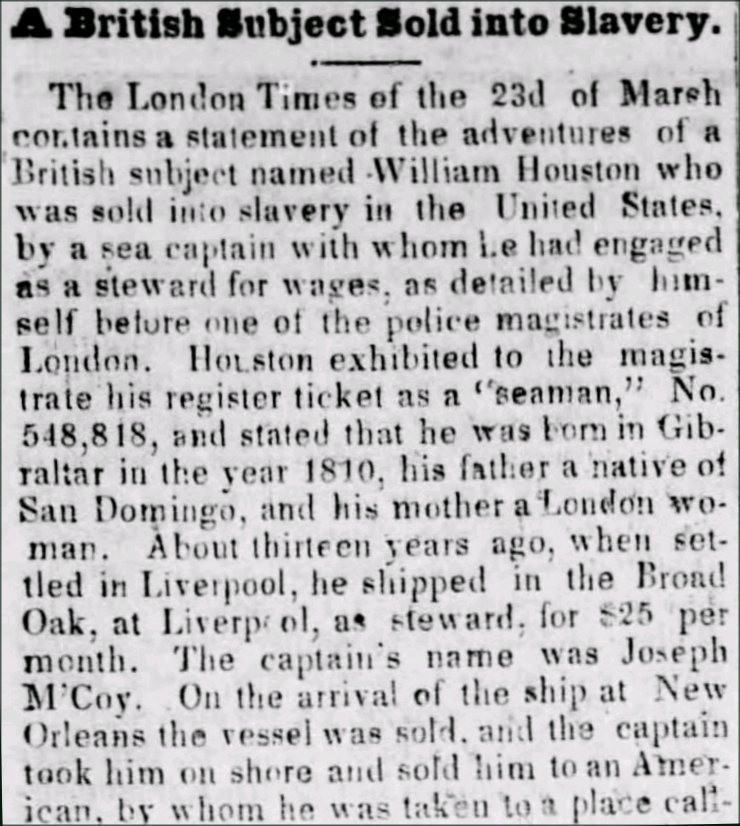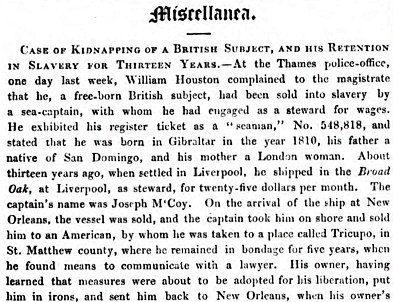A British subject enslaved in America


.
Our guest author, David Fiske, spent years investigating the life of Solomon Northup, the free Black man whose kidnapping and enslavement was the basis for the film ‘12 Years a Slave’. Sadly the tragedy that befell Northup was not unique. David shares the history of William Houston, a free Black man living here in Liverpool (UK) in around 1840, who was enslaved in America:
"The 2013 film ‘12 Years a Slave’ earned awards from the Academy of Motion Picture Arts and Sciences ("the Oscars"), the British Academy Film Awards, and the Golden Globe Awards. The film told the true story of Solomon Northup, a free Black American citizen who went to Washington DC in 1841 after some men promised him employment. Instead he was sold into slavery and taken south to the state of Louisiana. Fortunately he was rescued from slavery, but not until 1853. His story was told in newspaper articles and also in his own book, ‘Twelve Years a Slave’ (upon which the film is based).
Sadly, the tragedy that befell Northup was not unique to his case. Many other free Black people were victims of the same sort of kidnapping. Hundreds, perhaps thousands, were enslaved, either forcibly or by trickery.
Even British subjects were not immune. William Houston, born in Gibraltar, was the son of a man from San Domingo (also known as Hispaniola) and a London woman. The family moved to Liverpool and, around the year 1840, Houston signed on as a steward for a ship heading to America. This ship, Broad Oak, arrived in New Orleans in Louisiana, where Houston stayed for a few days. On the city's streets, Houston encountered the master of the Broad Oak, and he expressed his desire to return to England. He was then directed to a man who put him on a steamboat, which Houston thought would take him to New York and then back across the ocean. Instead he was taken into the interior of Louisiana, had his papers taken away from him, and was forced to work as a cook. About five years later Houston was able to confer with a lawyer, but his owner carried him back to New Orleans and sold him to another man before anything could come of it.

Houston was sold several times, and one master hired him out to someone else (a common practice). He became the servant of Captain William T Wills, an army officer who took Houston with him as he went to fight in the war with Mexico, where Houston was a drummer. After being wounded, Houston spent time recuperating, and then ended up back in New Orleans. There he was sold again, but he also had the chance to start explaining that he was actually a British subject, wrongfully enslaved. In time he was able to speak with William Mure, the British Consul at New Orleans. After a few setbacks he was able to board a ship for England, thanks to Mure's assistance.
Arriving back in England, Houston made his way to London, where he made a complaint with a magistrate against the ship's master who had diverted him into slavery years earlier. Unfortunately, the magistrate did not have the authority to pursue the case. Questions arose regarding certain details of Houston's story, and there were some who thought he might be a fraud. Others firmly believed him, and the story of his sufferings was reported in many American newspapers, as well as the Times of London (23 March 1852), and the Anti-Slavery Reporter (1 April 1852), published by the British and Foreign Anti-Slavery Society.
The available sources of information do not provide further details on Houston. It is unclear whether his efforts to obtain redress were successful."
Find out more about David Fiske, who lives in New York State (USA) in the town adjoining Saratoga Springs, where Solomon Northup lived prior to his being kidnapped. His work includes ‘Solomon Northup's Kindred: The Kidnapping of Free Citizens before the Civil War’, which includes information about Houston.
